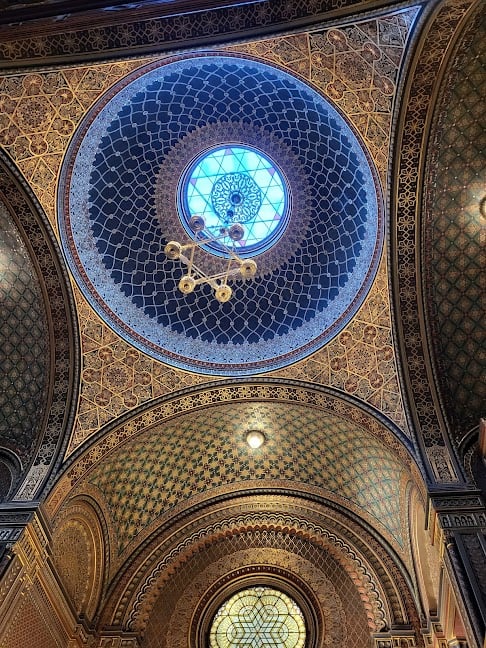Spanish Synagogue





What people say
Pedro Pereira
Available for hire
"The Spanish Synagogue in Prague is notable for its rich history and striking architectural style. It occupies the site of the former Altschul (Old Synagogue), which was one of the earliest synagogues in the Prague Jewish Town. By the late 19th century, the Altschul could no longer accommodate the growing Jewish community. Consequently, in 1867, the synagogue was demolished to make way for the new Spanish Synagogue, completed in 1868. The name "Spanish Synagogue" refers to its Moorish Revival style, which draws inspiration from the art and architecture of the Arabic period of Spanish history. Initially, it was referred to by German-speaking Jews as the Geistgasse-Tempel (Temple in Holy Spirit Street).
Architects Vojtěch Ignác Ullmann and Josef Niklas designed the new structure, which features a magnificent interior. The synagogue is two stories high with a square ground plan, and the main hall is topped by a dome. Surrounding this hall are three built-in balconies, with an organ located on the southern balcony. A large round stained glass window with a central Magen David (hexagram) adorns the eastern wall, beneath which is a monumental aron ha-kodesh (Torah ark).
The interior decoration, carried out between 1882 and 1893, is one of the most remarkable features of the synagogue. It includes a gilded and multi-colored parquet arabesque, designed by Antonín Baum and Bedřich Münzberger, reflecting influences from Arabic architecture and art. The synagogue's design is reform-oriented, with the bimah (reading platform) situated in the eastern wall, rather than in the central space, which is typical of older synagogues. The benches are arranged in rows, similar to a church, rather than along the walls as in traditional synagogues.
In 1935, a functionalist building designed by Karel Pecánek was added to the synagogue, which served as a hospital for the Jewish community until World War II. During the war, the synagogue was used to store the confiscated properties of Czech Jewish communities, including furniture from other synagogues. After the war, it was handed over to the Jewish Museum and underwent a complete restoration from 1958 to 1959. In the following years, it hosted an exhibition of synagogue textiles.
The building fell into neglect during the 1970s and was closed in 1982. Restoration efforts resumed after the Velvet Revolution, and the synagogue was ceremoniously reopened in 1998, restored to its former beauty. Today, the Spanish Synagogue stands as a significant testament to Jewish heritage in Prague, celebrated for its unique architectural style and historical importance. "
Read more in:
Silvia De Caro
Available for hire
"It is the last synagogue built in the capital of the Czech Republic, and is considered the most beautiful in the Jewish quarter of Prague.
The name Spanish Synagogue derives from the suggestive Moorish-style decor of its interior, for which architects Antonín Baum and Bedřich Münzberge were inspired by the famous Alhambra in Granada.
👣How to get there: reachable on foot from Church of Our Lady before Tyn (350m,5 min). Metro stop: Staroměstská,Line A.
🎟️Ticket cost: full price 200 CZK (equivalent to approximately €7.50)."
Read more in:
sara shepherd
Available for hire
"Jews are believed to have settled in Prague as early as the 10th century and the population remains pretty high even through some terrible times. The Jewish Museum is spectacular and I think worth a visit not only for the memory of the atrocities that happened but also for the building itself. - Another David Cerny is the front. "
Mentioned in these guides
About Spanish Synagogue
Get the inside scoop on Spanish Synagogue from local experts, travel creators, and tastemakers. Browse genuine trip notes, Spanish Synagogue reviews, photos, travel guides, and itineraries from real travelers and plan your trip with confidence.
Phone
Save this spot for later or start mapping out a new trip today
Try our AI Travel Assistant and get instant answers to any questions about your trip.
Ask ThatchGPT


